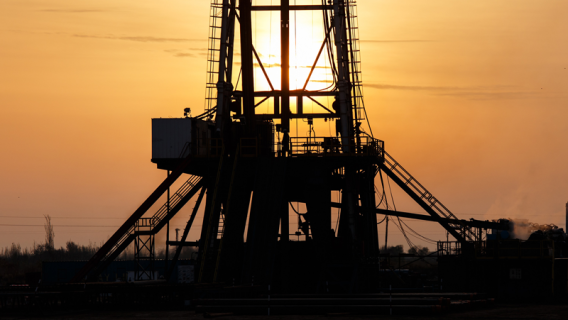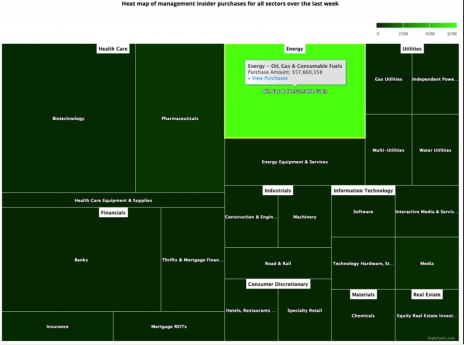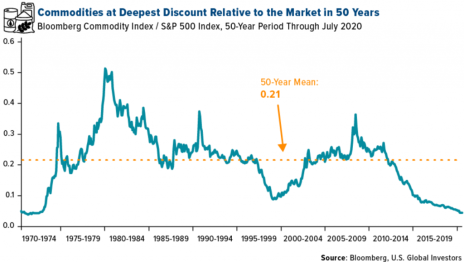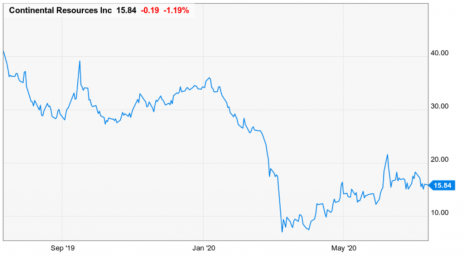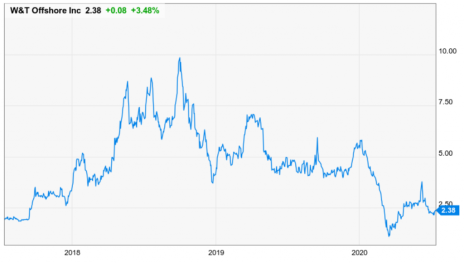Following insider buying is a time-tested strategy for generating excess returns. With that in mind, let’s review the data to see whether insiders are buying their own shares today.
During the depths of the S&P 500’s plunge in March, the insider sell/buy ratio was 0.88, according to data from Insider Arbitrage. This marked the first time in 10 years that there were more insider buys than insider sells.
It proved to be an opportune time to buy as the S&P 500 has surged 42% from its March 23 trough.
Last week, the insider sell/buy ratio was 10.1. In other words, there were 10x more insider sells than buys.
[text_ad]
Despite this unfavorable sell/buy ratio, there was one area of the market where insiders were buying hand over fist: Energy.
It makes sense.
Commodities are trading at their deepest discount to the S&P 500 in 50 years….
It’s no wonder energy insiders see clear value.
Over the past couple weeks, there have been two energy stocks that have seen strong insider buying.
Let’s start with Continental Resources.
Insider Buying in Continental Resources (CLR)
Last week, Continental Resources founder and Executive Chairman acquired 2,679,849 shares of Continental Resources (CLR). He paid $17.77 per share for a total purchase price of ~$48 million.
This purchase follows another large purchase (~$73 million) that Hamm made the previous week. Clearly, he sees value in his company.
Counting his most recent purchase, Hamm owns over 80% of shares outstanding of this $6 billion market cap fracking leader. The recent insider buying makes me wonder whether he is planning on taking the company private at some point in the near future.
Let’s take a step back and get familiar with CLR and its outlook.
CLR is an independent crude oil and natural gas company that was formed in 1967.
The majority of CLR’s oil and natural gas production, as well as its proved reserves (53% of total), come the from North (the Bakken field of North Dakota and Montana). The balance of oil and gas production and proved reserves (47% of total) comes from the South (mainly Oklahoma).
When evaluating an oil and gas company in the current environment, the first and most important question to ask is, “Is there a bankruptcy risk?”
CLR does have a significant amount of net debt ($5.5 billion), especially in the context of how much cash flow the company generates. Over the last 12 months, the company generated over $3.0 billion of cash flow from operations. Due to the March plunge in crude prices, CLR cut its capex plans back and now plans to spend $1.2 billion (down 55% y/y) in 2020. However, capex could be cut back further if needed.
Further, CLR has no meaningful debt maturities until 2022.
As a result, I’m comfortable that bankruptcy risk for CLR is low.
Now let’s consider the upside. First, the stock’s valuation at 15x forward earnings is not demanding considering the depressed operating environment.
Looking at the long-term chart, one can see CLR traded over 70 per share in 2018. Thus, there would be significant upside if (or when) the energy industry recovers.
When I’m evaluating investment opportunities, I’m looking for asymmetry. What does that mean? Limited downside and many multiples of upside in a positive scenario. With CLR, it looks like we have an asymmetric setup.
Insider Buying in W&T Offshore, Inc. (WTI)
W&T Offshore, Inc. (WTI) is another company with heavy insider buying and an asymmetric risk/reward setup.
Last week, Chairman, CEO and President Tracy Krohn acquired 632,334 shares at a price of $2.15 per share for a total cost of $1.4 million. In total, Krohn now owns 47,391,459 shares, or 33% of shares outstanding.
Separately, Director Virginia Boulet acquired 18,604 shares at a price of $2.20 per share for a total cost of $40,927. In total, Boulet owns 255,177 shares.
W&T Offshore Inc is an oil and gas exploration and production company. The company’s exploration operations are focused in the Gulf of Mexico, where it drills for oil and gas. The company engages in both deep-water drilling and shallow-water shelf drilling. While WTI drills for both crude oil and natural gas, crude accounts for most of the company’s revenue.
WTI’s situation is a little more precarious.
It has ~$520 million of net debt on its balance sheet but doesn’t have any meaningful maturities until 2022. Further, it has $48 million of cash on its balance sheet and a revolving line of credit for $135 million.
In 2016, the last time we saw a plunge in crude prices, WTI generated just $14 million of operating cash flow so we can expect something similar in 2020. The company has cut capex drastically and only expects to spend $23 million in the rest of 2020. As a result, I would expect the company’s cash loss in 2020 to be manageable given its cash balance.
If the energy markets recover over the next couple of years, WTI should trade considerably higher. In 2018, the share price traded as high as 9.84.
Again, we have an asymmetric opportunity. There is limited risk of bankruptcy in the near term yet, in a positive scenario, the stock would be multiples higher. To be fair, I think the risk of bankruptcy is higher for WTI than it is for CLR.
If you can stomach the volatility and appreciate asymmetric opportunities, WTI and CLR are both worth a speculative investment.
[author_ad]

